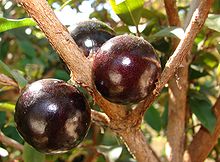- Jabuticaba
-
Jabuticaba 
Scientific classification Kingdom: Plantae (unranked): Angiosperms (unranked): Eudicots (unranked): Rosids Order: Myrtales Family: Myrtaceae Genus: Myrciaria Species: M. cauliflora Binomial name Myrciaria cauliflora
(Mart.) O.BergThe Jabuticaba (Myrciaria cauliflora (Mart.) O.Berg.) (also called Brazilian Grape Tree, Jaboticaba, Jabotica, Guaperu, Guapuru, Hivapuru, Sabará and Ybapuru) is a fruit-bearing tree in the family Myrtaceae native to Minas Gerais in southeastern Brazil grown for the purple, grape-like fruits it produces. Other related species in the genus Myrciaria, often referred to by the same common name, are native to Brazil, Argentina, Paraguay, and Bolivia. The fruit is purplish black, with a white pulp; it can be eaten raw or be used to make jellies and drinks (plain juice or wine).
Contents
Description
The fruit tree (named jabuticabeira in Portuguese) has salmon-colored leaves when they are young, turning green posteriorly. It is a very slow growing tree which prefers moist, lightly acidic soils for best growth. It is widely adaptable, however, and grows satisfactorily even on alkaline beach-sand type soils, so long as they are tended and irrigated. Its flowers are white and grow directly from its trunk in a cauliflorous habit. Naturally the tree may flower and fruit only once or twice a year, but when continuously irrigated it flowers frequently, and fresh fruit can be available year round in tropical regions.
The fruit is 3-4 cm in diameter with one to four large seeds, borne directly on the main trunks and branches of the plant, lending a distinctive appearance to the fruiting tree. It has a thick, purple, astringent skin that covers a sweet, white, or rosy pink gelatinous flesh. Common in Brazilian markets, jaboticabas are largely eaten fresh; their popularity has been likened to that of grapes in the US. Fresh fruit may begin to ferment 3 to 4 days after harvest, so they are often used to make jams, tarts, strong wines, and liqueurs. Due to the extremely short shelf-life, fresh jaboticaba fruit is very rare in markets outside of areas of cultivation. Traditionally, an astringent decoction of the sun-dried skins has been used as a treatment for hemoptysis, asthma, diarrhoea, and gargled for chronic inflammation of the tonsils.
Several potent antioxidant and anti-inflammatory anti-cancer compounds have been isolated from the fruit.[1] One that is unique to the fruit is jaboticabin.
In Brazil the fruit of several species, namely M. jaboticaba (Vell.) O.Berg, M. tenella (DC.) O.Berg, and M. trunciflora O.Berg, share the same common name. While all jaboticaba species are subtropical, all can tolerate mild, brief frosts, and some species may be marginally more cold-tolerant. Commercial cultivation of the fruit in the Northern Hemisphere is more restricted by extremely slow growth and the short shelf-life of fruit than by temperature requirements. Grafted plants may bear fruit in 5 years; seed grown trees may take 10 to 20 years to bear fruit, though their slow growth and small size when immature make them popular as bonsai or container ornamental plants in temperate regions. Jaboticabas are fairly adaptable to various kinds of growing conditions, tolerating sand or rich topsoil. They are intolerant of salty soils or salt spray. They are tolerant of mild drought, though fruit production may be reduced, and irrigation will be required in extended or severe droughts.
Cultural aspects
The name jaboticaba, derived from the Tupi word Jabuti (tortoise) + Caba (place), meaning the place where you find tortoises, has its correct spelling in Guarani as "Yvapuru", where yva means fruit, and the onomatopoeic word purũ for the crunching sound the fruit produces when bitten.
The jaboticaba tree, which appears as a charge on the coat of arms of Contagem, Minas Gerais, Brazil,[2] has become a widely used species in the art of bonsai, particularly in Taiwan and parts of the Caribbean.
References
- ^ Reynertson KA, Wallace AM, Adachi S, Gil RR, Yang H, Basile MJ, D'Armiento J, Weinstein IB, Kennelly EJ. Bioactive depsides and anthocyanins from jaboticaba (Myrciaria cauliflora). J Nat Prod. 2006 Aug;69(8):1228-30 PMID 16933884 DOI: 10.1021/np0600999.
- ^ Brazilian Flags
External links
- Jaboticaba California Rare Fruit Growers.
- Jaboticaba Features and growing conditions.

This Myrtaceae article is a stub. You can help Wikipedia by expanding it.


